Guernica
Guernica (UK: /ɡɜːrˈniːkə, ˈɡɜːrnɪkə/,[2] Spanish pronunciation: [ɡeɾˈnika]), official name (reflecting the Basque language) Gernika (pronounced [ɡernika]), is a town in the province of Biscay, in the Autonomous Community of the Basque Country, Spain. The town of Guernica is one part (along with neighbouring Lumo) of the municipality of Gernika-Lumo (Spanish: Guernica y Luno, whose population is 16,224 as of 2009.
Guernica Guernica y Luno | |
|---|---|
City | |
| Gernika-Lumo | |
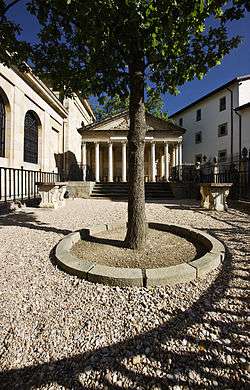 The Oak of Gernika (Gernikako Arbola) | |
 Flag  Coat of arms | |
 Guernica Location of Guernica within the Basque Country  Guernica Guernica (Spain) | |
| Coordinates: 43°19′N 02°40′W | |
| Country | |
| Autonomous community | |
| Province | Biscay |
| Eskualdea / Comarca | Gorbeialdea |
| Founded | April 28, 1366 |
| Government | |
| • Mayor | Jose Maria Gorroño Etxebarrieta (EAJ-PNV) |
| Area | |
| • Total | 8.6 km2 (3.3 sq mi) |
| Elevation (AMSL) | 10 m (30 ft) |
| Population (2018)[1] | |
| • Total | 16,972 |
| • Density | 2,000/km2 (5,100/sq mi) |
| Demonym(s) | gernikarra |
| Time zone | UTC+1 (CET) |
| • Summer (DST) | UTC+2 (CEST) |
| Postal code | 48300 |
| Area code(s) | +34 (Spain) |
| Website | Official website |

Gernika is best known -- among those residing outside the Basque region -- both as the scene of the April 26, 1937 bombing of Guernica, one of the first aerial bombings (by Nazi Germany's Luftwaffe), and as the inspiration for Pablo Picasso's painting Guernica, depicting the effects of that outrage.
Location
This village is situated at 10m altitude, in the region of Busturialdea, in the valley of the Oka river. Its mouth is known as Urdaibai's estuary's heart. Gernika borders on the following townships:
History
Early history
The town of Guernica was founded by Count Tello on April 28, 1366, at the intersection of the road from Bermeo to Durango with the road from Bilbao to Elantxobe and Lekeitio. The strategic importance of the site was increased by the fact that it lay on a major river estuary, where vessels could dock at the port of Suso.
In time, it took on the typical shape of a Basque town, comprising a series of parallel streets (Goienkale, Azokekale, Artekale and Barrenkale; respectively: ‘upper, market, between, lower roads’) and a transverse street called Santa María, with a church at each end of the built-up area.
Life in the town became rigidly structured, with the aim being to preserve the privileges of the dominant middle classes. This pattern continued practically unaltered until the late 17th century.
On a small hillock in the town, stands the Meeting House and the famous Tree of Gernika. By ancient tradition, Basques, and indeed other peoples in Medieval Europe, held assemblies under a tree, usually an oak, to discuss matters affecting the community.
In Biscay, each administrative district (known as a merindad) had its appointed tree, but over the centuries, the Tree of Guernica acquired particular importance. It stood in the parish of Lumo, on a site known as Gernikazarra, beside a small shrine.
The laws of Biscay continued to be drawn up under this tree until 1876, with each town and village in the province sending two representatives to the sessions, known as General Assemblies. This early form of democracy was recorded by the philosopher Rousseau, by the poet William Wordsworth, by the dramatist Tirso de Molina and by the composer Iparragirre, who wrote the piece called Gernikako Arbola.
When the Domain of Biscay was incorporated into the kingdom of Castile, the king of Castile visited Guernica and swore an oath under the Tree promising to uphold the fueros or local laws of Biscay. The oath of King Ferdinand, known as the "Catholic Monarch", on June 30, 1476, is depicted in a painting by Francisco de Mendieta popularly known as El besamanos ("The Royal audience"). On July 3, 1875, during the Carlist Wars, the pretender to the throne Don Carlos also visited Guernica and swore the oath. Throughout the 19th century, there were frequent meetings under the Tree, including both General Assemblies and other political events.
By the 18th century, there was a square at the centre of the town, flanked by the town hall, a public gaol housing prisoners from all over the Lordship of Biscay, a hospital and a poor-house for local people. Day-to-day life comprised agriculture (growing of cereals, vegetable and fruit), crafts (menders, tailors, cobblers, flax manufacturers) and trade (transportation and sale of goods and produce).
This was also a time of continual conflicts with the neighbouring parish of Lumo over disputed land. These disputes were not finally settled until 1882, when the two parishes joined together to form Gernika-Lumo.
The first industrial concerns were set up in the early years of the 20th century. This encouraged population growth, and the town grew from 4,500 inhabitants in 1920 to 6,000 in 1936.
Modern history
On April 26, 1937, during the Spanish Civil War, Guernica was the scene of the Bombing of Guernica by the Condor Legion of Nazi Germany's Luftwaffe and the Italian Aviazione Legionaria.[3] According to official Basque figures, 1,654 civilians were killed,[4][5] but German sources report a round figure of 300 civilians killed in the bombing, according to the German Bundeswehr Magazine (published in April 2007, page 94). The raid was requested by Francisco Franco to aid in his overthrowing the Basque Government and the Spanish Republican government. The town was devastated, though the Biscayan assembly and the Oak of Guernica survived. The Bombing of Guernica, that went on continuously for three hours, is considered to be the beginning of the Luftwaffe doctrine of terror bombing, where civilian targets were selected to demoralize the enemy.[5] Pablo Picasso painted his famous Guernica painting to commemorate the horrors of the bombing and René Iché made a violent sculpture the day after the bombing. It has inspired musical compositions by Octavio Vazquez (Gernika Piano Trio) and René-Louis Baron, and poems by Paul Eluard (Victory of Guernica), and Uys Krige (Nag van die Fascistiese Bomwerpers) (English translation from the Afrikaans: Night of the Fascist Bombers). There is also a short film from 1950, by Alain Resnais, titled Guernica.
Celebrations were staged in 1966 to mark the 600th anniversary of the founding of the town. As part of these celebrations, a statue of Count Tello, made by local sculptor Agustín Herranz, was set up in the Fueros Square.
At present, Gernika-Lumo has 16,244 (2009) inhabitants. It is a town with a prosperous service sector, and is also home to industrial companies, as well as good cultural and educational amenities.
Cultural importance
Guernica is historically the seat of the parliament of the province of Biscay, whose executive branch is located in nearby Bilbao.
In prior centuries, Lumo had been the meeting place of the traditional Biscayan assembly, Urduña and chartered towns like Guernica were under the direct authority of the Lord of Biscay, and Enkarterri and the Durango area had separate assemblies. All would hold assemblies under local big trees. As time passed, the role of separate assemblies was superseded by the single assembly in Guernica, and by 1512, its oak, known as the Gernikako Arbola, became symbolic of the traditional rights of the Basque people as a whole.
The trees are always renewed from their own acorns. One of these trees (the "Old Tree") lived until the 19th century, and may be seen, as a dry stump, near the assembly house. A tree planted in 1860 to replace it died in 2004 and was in turn replaced; the sapling that had been chosen to become the official Oak of Guernica is also sick so the tree will not be replaced until the earth around the site has been restored to health.
A hermitage was built beside the Gernikako Arbola to double as an assembly place, followed by the current house of assembly (Biltzar Jauregia in Basque), built in 1826.
Symbol for peace
On April 26, 1937, during the Spanish Civil War, the town was razed to the ground by German aircraft belonging to the Condor Legion, sent by Hitler to support Franco's troops. For almost four hours bombs rained down on Guernica in an "experiment" for the blitzkrieg tactics and bombing of civilians seen in later wars.
In 1987 the 50th anniversary of the bombing was commemorated as the town hosted the Preliminary Congress of the World Association of Martyr Cities. The full congress was held subsequently in Madrid, bringing together representatives of cities all over the world. Since then, Gernika-Lumo has been a member of this association. 1988 saw the setting up of the monument Gure Aitaren Etxea, by Basque sculptor Eduardo Chillida, and in 1990 Large Figure in a Shelter, by British sculptor Henry Moore, was erected beside it. These monuments are symbolic of Gernika-Lumo as a city of peace.
As part of the "Symbol for Peace" movement, Gernika has twinned with several towns, including Berga (Catalonia – 1986), Pforzheim (Germany – 1988) and Boise, Idaho (United States – 1993). The twinning agreements include co-operation in the fields of culture, education and industry.
Market day
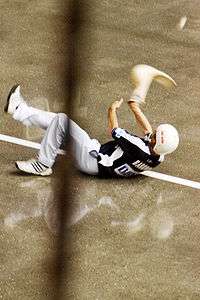
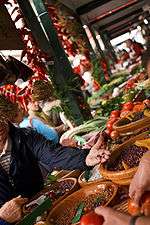
There is a popular saying in Guernica which runs as follows: "lunes gerniqués, golperik ez". This translates roughly as "not a stroke of work gets done on Mondays". The Monday market day has for decades been considered as a holiday in the town.
People would flock to Guernica not just from the immediate vicinity, but from all over the province, so that the town was packed. They came not just to buy or sell at the produce market, but also to eat at the town's renowned restaurants and afterwards perhaps to watch a pelota game at the local court. The Monday market has been fulfilling its age-old function of bringing people together since the times when people could not afford to travel far and it provided them with a chance to socialise. The bombing of Guernica by Nazi Germany's Luftwaffe and the Italian Aviazione Legionaria was deliberately chosen to occur on a Monday (April 26, 1937), because it was known that the Basque people who lived outside of Guernica proper would travel into town for the Market Day, thus affording the pilots of the German and Italian aircraft the opportunity to murder as many innocent people as possible.
Sports
Jai alai (cesta-punta) is a form of pelota. The Guernica jai alai court is the biggest operational court of its type in the world. It was designed by Secundino Zuano, one of Spain's leading architects of the 20th century and first opened in 1963. It is acknowledged by players of the game to be the world's finest court.
Bare-handed pelota games are held at the Santanape court. This is the most popular form of the sport.
Main sights
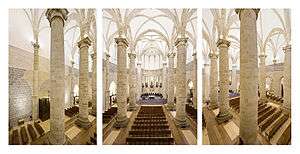
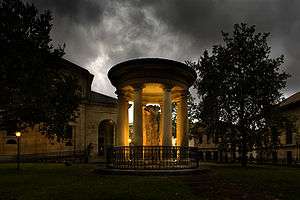
- Parish Church of Santa María. Work on this church, at the top of the town, began in 1418 in a Gothic style, and continued non-stop until 1625, though the finishing touches were not completed until 1715, in the Renaissance period.
- Church of Santa María de la Antigua. Built in 1826-33 by Antonio de Echevarría in the purest Neo-classical style, this building is currently used as the plenary meeting hall of the General Assemblies of Biscay.
- Large Figure in a Shelter (1986) by the sculptor Henry Moore. This sculpture is typical of the themes and style of this artist, and the most significant example of his "inside/outside" motif. Cast in bronze, it weighs around 20 tonnes.
- Monument to Peace, by the Basque sculptor Eduardo Chillida. This figure, set up on April 27, 1988, was commissioned by the Basque Government to commemorate the 50th anniversary of the bombing of Guernica. The title in Basque means "Our Father's House", and the work stands looking towards the Tree (the symbol of Basque traditions and history) as a monument to peace.
- Park of the Peoples of Europe. This contains examples of all four types of woodland found on the Basque coast: beech woods, oak woods, holm-oak woods and riverside brush. It is also the site of Moore's and Chillida's sculptures and Humboldt's bronze head.
- Palacio de Alegría mansion. This mansion was rebuilt in its entirety in the mid-18th century. All that remains of the earlier building is a loop-hole and one window. It is built in the typical urban Baroque style with an ashlar-work façade, trellised balconies and the coat of arms of the Allende Salazar family. The mansion now houses the Museum of the Basque Country, whose exhibits highlight physical, political, economic and linguistic features of Basque history and renowned Basque personages.
- Guernica Peace Museum Foundation, a museum of the history of Guernica. The exhibits illustrate what Guernica has represented throughout its history for the Basques (democracy, local legal system, freedom) and what it stands for today all over the world (human rights, peace). The Gernika Peace Museum is a theme museum setting out the culture of peace. It was inspired by the tragic bombing of Guernica on 26 April 1937.
- Euskal Herria Museum, housed in the palace of Alegría or Montefuerte, a 1733 baroque reconstruction of an ancient medieval tower. Set in the historical heart of Gernika-Lumo, it survived the 1937 bombing. The Museum is located near the Casa de Juntas (old Assembly House) and the Tree of Guernica, and surrounded by old gardens now turned into the Parque de los Pueblos de Europa (Park of the European Nations). The Regional Council of Biscay acquired the site in 1982 and refurbished it as a Museum with the aim of presenting an exhibition to promote the understanding of the historical, political and cultural meaning of the spiritual community of Euskal Herria.
- Reproduction of Picasso's Guernica. A mosaic of tiles which depicts in puzzle form Picasso's great work Guernica, the original of which is currently on display at the Reina Sofia Museum in Madrid. The inscription beneath this impressive mural expresses the desire of local people for the original canvas to be put on display in the town which inspired its creation: Guernica.
Twin towns – sister cities
References
- Municipal Register of Spain 2018. National Statistics Institute.
- "Guernica". Oxford Dictionaries UK Dictionary. Oxford University Press. Retrieved January 26, 2019.
- "Eighty years later, the Nazi war crime in Guernica still matters". The Independent. 2017-04-27. Retrieved 2020-01-03.
- "Bombings in Basque Country (Workbook)". Euskadi.eus (Basque Government website) (in Spanish). Retrieved 2020-01-01.
- "Guernica". History Learning Site. Retrieved 2020-01-03.
External links
| Wikiquote has quotations related to: Bombing of Gernika |
| Wikimedia Commons has media related to Gernika-Lumo. |
- Official site in English, Basque and Spanish
- writer and filmmaker Begonya Plaza interviewed survivors, and people of importance in Guernica in 1987 in documentary "GERNICA LIVES"
- Painter and art educator Dorothy Koppelman writes "Art Opposes Injustice: Picasso’s Guernica"
- GERNIKA-LUMO in the Bernardo Estornés Lasa – Auñamendi Encyclopedia (Euskomedia Fundazioa) (in Spanish)
- Web page about Gernika-Lumo with great photos of it.
